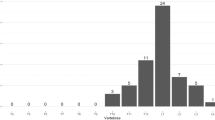Abstract
A prospective cohort study of 1098 postmenopausal Japanese-American women evaluated the relationship between baseline non-spine fractures and new (incident) spine fractures. At the baseline examination in 1981, prevalent non-spine fractures were ascertained by interview, and prevalent spine fractures by radiograph. Bone mass measurements of the distal radius, proximal radius, calcaneus (1981), the lumbar spine (1984) were obtained and repeated at 1- to 2-year intervals. Women with existing non-spine fractures have a threefold greater risk of subsequent spine fractures, independent of bone mass, and independent of the known association between prevalent spine fractures and subsequent spine fractures. Women with both a prevalent non-spine fracture and low bone mass (50th percentile or lower) have an eightfold greater risk of new spine fractures compared with women above the 50th percentile of bone mass and no prevalent fractures. In addition to low bone mass, both prevalent spine fractures and prevalent non-spine fractures are strong risk factors for subsequent spine fracture. These data suggest that not all osteoporotic risk factors are expressed via bone mass, and that other, unmeasured risk factors, such as bone quality defects, may explain these results. In clinical terms, women with both prevalent fractures and low bone mass should be recognized as being at extremely high risk, and treatment potency should be commensurate with this level of risk.
Similar content being viewed by others
References
Wasnich RD, Ross PD, Heilbrun LK, Vogel JM. Prediction of postmenopausal fracture risk with bone mineral measurements. Am J Obstet Gynecol 1985;153:745–51.
Hui SL, Slemenda CW, Johnston CC Jr. Baseline measurement of bone mass predicts fracture in white women. Ann Intern Med 1989;111:355–61.
Cummings SR, Black D, Nevitt MC, et al. Appendicular densitometry and age predict hip fracture in women. JAMA 1990;263:665–8.
Wasnich RD, Ross PD, MacLean CJ, Vogel JM, Davis JW. A comparison of single versus multi-site BMC measurements for assessment of spine fracture probability. J Nucl Med 1989;30:1166–71.
Ross PD, Davis JW, Wasnich RD, Vogel JM. A critical review of bone mass and the risk of fractures in osteoporosis. Calcif Tissue Int 1990;46:149–61.
Ross PD, Davis JW, Epstein RS, Wasnich RD. Pre-existing fractures and bone mass predict vertebral fracture incidence in women. Ann Intern Med 1991;114:919–23.
Owen RA, Melton LJ III, Ilstrup DM, Johnson KA, Riggs BL. Colles' fracture and subsequent hip fracture risk. Clin Orthop 1980;152:35–43.
Melton LJ III, Ilstrup DM, Beckenbaugh RD, Riggs BL. Hip fracture recurrence: a population-based study. Clin Orthop 1982;167:131–8.
Gardsell P, Johnell O, Nilsson BE, Nilsson JA. The predictive value of fracture, disease, and falling tendency for fragility fractures in women. Calcif Tissue Res 1989;45:327–30.
Murray TM, Harrison JE, Bayley TA, et al. Fluoride treatment of postmenopausal osteoporosis: age, renal function, and other clinical factors in the osteogenic response. J Bone Miner Res 1990;5(Suppl 1):S5-S26.
Stewart TM. Fracture of neck of femur: survival and contralateral fracture. BMJ 1957;2:922.
Yano K, Wasnich RD, Vogel JM, Heilbrun LK. Bone mineral measurements among middle-aged and elderly Japanese residents in Hawaii. Am J Epidemiol 1984;119:751–64.
Heilbrun LK, Kagan A, Nomura A, Wasnich RD. The origins of epidemiologic studies of heart disease, cancer and osteoporosis among Hawaii Japanese. Hawaii Med J 1985;44:294–6.
Ross PD, Wasnich RD, Davis JW, Vogel JM. Vertebral dimension differences between Caucasian populations and between Caucasians and Japanese. Bone 1991;12:107–12.
Seeley DG, Browner WS, Nevitt MC, Genant HK, Scott JC, Cummings SR. Which fractures are associated with low appendi-cular bone mass in elderly women? Ann Intern Med 1991;115:837–42.
Nevitt MC, Cummings SR, Browner WS, Seeley DG, Cauley JA, Vogt TM, Black DM. The accuracy of self-report of fractures in elderly women: evidence from a prospective study. Am J Epidemiol 1992;5:490–9.
Wasnich RD, Ross PD, MacLean CJ, Davis JW, Vogel JM. The relative strengths of osteoporotic risk factors in a prospective study of postmenopausal osteoporosis. In: Osteoporosis 1987. Christiansen C, Johansen JS, Riis BJ, editors. Osteoporosis 1987. Copenhagen: Osteopres, 1987:394–5.
Ross PD, Ettinger B, Davis JW, Melton LJ III, Wasnich RD. Evaluation of adverse health outcomes associated with vertebral fractures. Osteoporosis Int 1991;1:134–40.
Author information
Authors and Affiliations
Rights and permissions
About this article
Cite this article
Wasnich, R.D., Davis, J.W. & Ross, P.D. Spine fracture risk is predicted by non-spine fractures. Osteoporosis Int 4, 1–5 (1994). https://doi.org/10.1007/BF02352253
Received:
Accepted:
Issue Date:
DOI: https://doi.org/10.1007/BF02352253




